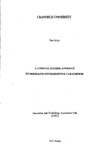JavaScript is disabled for your browser. Some features of this site may not work without it.
| dc.contributor.advisor | Allen, Peter M. | |
| dc.contributor.author | Oxley, Tim | |
| dc.date.accessioned | 2009-11-13T12:50:20Z | |
| dc.date.available | 2009-11-13T12:50:20Z | |
| dc.date.issued | 1994-08 | |
| dc.identifier.uri | http://hdl.handle.net/1826/3959 | |
| dc.description.abstract | In recognition of the widespread deterioration of the natural environment, and the continual emergence of sudden catastrophic environmental changes resulting from complex interactions of theretofore apparently disparate phenomena, this research presents a complex systems approach to the modelling of such environmental catastrophes. Recognizing contemporary views of complexity and evolution, this research presents a dynamic complex systems model which displays emergent characteristics which can be directly related to the modelled phenomena - linking acid rain and eutrophication - and the study region, the Rutland Water catchment. This is achieved through the definition of a catastrophe indicator which indicates both the proximity and magnitude of catastrophe arising from the non-linear and discontinuous acid-phosphorus relationship within the soil domain which lies at the heart of this Chemical Time Bomb phenomenon. This facilitates assessment of the vulnerability of the Rutland Water catchment to potential propagation of this CTB given continued acidification and phosphate accumulation. The main contributions of this research may thus be found in the following areas: Development of a dynamic complex systems model - transferable to alternative catchments due to the minimal data requirements and its generic representation - which may be used to describe non-point sources of phosphates as part of assessments of potential eutrophication, overcoming such limitations found in existing models. * Definition of a catastrophe indicator( Re)- which highlights both the proximity and magnitude of catastrophe describing a specific Chemical Time Bomb phenomenon whereby the soil suddenly changes from being a sink to a source of phosphates; long-term accumulations of phosphate in the soil being released as a consequence of soil acidification in the short-term. Presentation of a complex systems approach - hinged upon this concept of a catastrophe indicator - to the representation of non-linearities and discontinuities between heretofore apparently disparate phenomena which are 'competing for a common resource. | en_UK |
| dc.language.iso | en | en_UK |
| dc.publisher | Cranfield University | en_UK |
| dc.title | A complex systems approach to modelling environmental catastrophe | en_UK |
| dc.type | Thesis or dissertation | en_UK |
| dc.type.qualificationlevel | Doctoral | en_UK |
| dc.type.qualificationname | PhD | en_UK |
